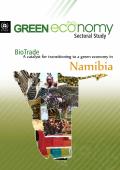There are currently debates in many countries on whether or not to adjust or correct the measure of gross domestic product (GDP) for deterioration of the state of the environment and depletion of natural resources. The surge in interest for developing such a "green GDP" can perhaps be traced back to the World Commission on Economy and Development's report "Our common future" (WCED, 1987) and the follow-up conference in Rio de Janeiro in 1992, (UNCED). Also the process of revising the system of national accounts (SNA) and the emergence of a "blue book" on System for Economic and Environmental Accounting (SEEA) (UN, 2003) have played an important role in motivating these debates.
This report is an effort to summarise international experiences and current status with regard to the development of a "green GDP". The context is an ongoing debate in China on how to measure performance at the national and local level in a way that not only gives incentives for economic development, but also take due notice and care of the impact on the environment and the natural resources of the unprecedented economic development taking place in parts of China.
This publication includes the latest available economic, financial, social and environmental indicators for the 48 regional members of the Asian Development Bank (ADB). It aims to present the latest key statistics on development issues concerning the economies of Asia and the Pacific to a wide audience. Part I of this issue is a special chapter on green urbanisation in Asia. This chapter tackles two growing concerns: environmental sustainability and rapid urbanisation. It argues that proper management of the urbanisation process can mitigate the environmental impacts and lead to a better life for the region's urban residents. Parts II and III comprise of brief, non-technical analyses and statistical tables on the millennium development goals (MDGs) and seven other themes. This summary was prepared by Eldis.
The concept of green growth rests on the idea of an efficiency revolution: green and climate-friendly innovations, huge investments to restructure the industrial, building and transport sectors, and a boost for using resources and energy more productively and efficiently. This study explores a fatal fallacy of the notion of green growth: while vast productivity increases do indeed incentivise a more efficient use of energy (and resources), they also raise demand. This rebound effect nullifies a considerable proportion of the savings potential of efficiency technologies and measures. Moreover, although the causal link between increased energy productivity and increased demand is well-established, rebound effects are still ignored in the majority of energy and climate studies and policies. This paper explores a range of possible rebound effects, outlines their quantitative extent and describes the difficulties encountered by political efforts to contain them. This summary was prepared by Eldis.

The growing global demand for medicinal and aromatic plants (MAPs) could help drive Nepal’s green economy, while improving livelihoods in its poorest communities. The study focuses on the cultivation, processing and trade of high-value MAPs, which are found in the forests and grasslands of the mountains in the northern part of the country. Given Nepal’s high degree of biodiversity, the study confirms Nepal’s significant potential to develop its BioTrade sector. This study is part of Capacity Building for BioTrade (CBBT) project, which is implemented by UNEP with financial support from Germany, and has conducted similar studies in Namibia and Peru.
